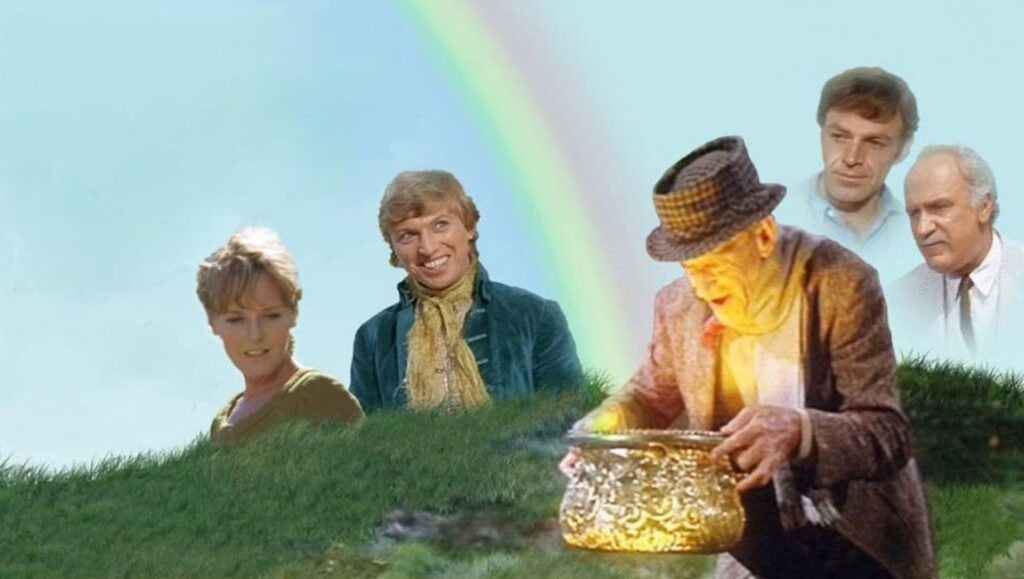It’s interesting — the degree of profundity with which one interprets the word “interesting” here obviously being a “your mileage may vary” situation — that Francis Ford Coppola and Martin Scorsese, the two most important Italian-American filmmakers of the second half of the century, both made grand homages to the classic Hollywood musical, with only one being a masterpiece, the other thoroughly mediocre. Marty’s New York, New York, is the masterpiece. Finian’s Rainbow, Coppola’s third film and second for a studio, is, almost 60 years later, more intriguing as a practice work, a student studying the masters, studying so that he will himself soon become one. In this regard, Finian’s Rainbow may have been necessary. Fred Astaire plays Finian, an Irish confidence man always finagling stratagems and coming up with duplicities for quick wins. He has just fled Ireland for America, with a purloined trove of gold in his hands and his unwitting daughter at his side, hoping to use silly magic to make his money proliferate. Hot on his trail is a pissed-off leprechaun, played by Tommy Steele (a former sea merchant who became, quite unlikely, England’s reigning 1950s rock star and sexy cultural idol, progenitor of the era’s dominant style of young cool Brit and, briefly, an aspiring movie star, which never quite happened; he instead found a career as a minor stage thespian). Soon enough, there are land squabbles, rampant capitalist chicanery, and racism — all essential to America circa 1968. Coppola has always been a deeply, profoundly American filmmaker, and here we find many of the themes pervading his oeuvre as well as hints of his aesthetic ambitions. But it just all feels too dumb to be taken seriously, and not a fun enough kind of dumb. The film is listless and saccharine, as sickly sweet as a mound of Splenda. The ending is, in every way, from spirit to aesthetic, antipodal to The Godfather (any of them), and The Conversation, and Apocalypse Now. Coppola would later nail the persnickety demands of the happy ending with Peggy Sue Got Married, which expounds with far more meaning and adroitness on Finian’s themes. The film is quite simply the worst of Coppola’s studio films, totally devoid of the moaning malaise of modern humanity that defines his classic New Hollywood works. And it looks like kid’s stuff next to his weird, 2000s digital work — the quaking ennui and treacherous beauty of Tetro and Youth Without Youth and Twixt.
In its fawning artifice and hyper-vibrant variegation of colors and eccentricities, Finian’s Rainbow is, we can now safely say with the benefit of time, something of a practice effort for the bravado and ingenious razzle-dazzle of One From the Heart, which came out 13 years later, made for over $20 million. But whereas Finian’s Rainbow helped open doors for Coppola, his second, brilliant musical, less an homage to classic Hollywood than a ballsy and at times quite brutal usurpation of it, ended up almost ruining Coppola, consequenting a decade-plus of paycheck gigs to repay the crazy debts accrued from being a visionary. Here, Astaire and the music (Ray Heindorf’s score got an Oscar nod, as did the film’s sound) are the only things people really talk about on those uncommon occasions when the film comes up beyond its passing mention as a forgettable Coppola — his last such film: the next year, he would make The Rain People, a stunning, somber work of traditional Hollywood filmmaking, and you see the insinuation of genius that would blossom with The Godfather. But the photography by the redoubtable Philip Lothrop (whose work in John Boorman’s amazing avant-garde pop-art Point Blank remains, to the true cinephiles — whether still in the thralls of celluloid or worn-out and jaded — and the common viewer with the capacity to enjoy the sublime, absolutely stunning) is really the best part of the movie. That he and Coppola seem a little constrained by convention, budget, and still-developing skill is obvious, but those flourishes of style still awe.
For a less generous take on what is undeniably a sum stain on Coppola’s oeuvre, however, I’ll leave you with Dave Kehr, stating in less than a hundred words what I, using many more, simply cannot bring myself to say: “This pretentious whimsy (1968) defeated Francis Coppola — though he tries valiantly, he sinks the movie with stolid action sequences and gushy lyrical effects. It’s Fred Astaire’s last musical and a sorry farewell. The story, of a leprechaun and a southern senator who turns up in blackface, dated horribly in the long interim between the Broadway run and the screen mounting, but the Lerner and Lane score remains catchy despite the moldy book. With too much of Tommy Steele, Don Francks, and Keenan Wynn, and not enough of Petula Clark, who had every right to a distinguished career in musicals.”
Published as part of Francis Ford Coppola: As Big As Possible.


Comments are closed.